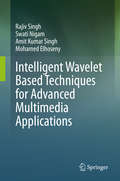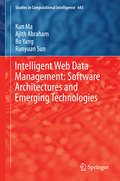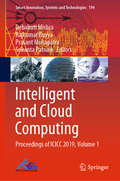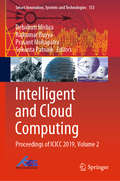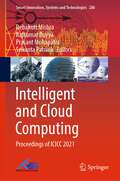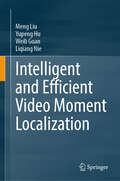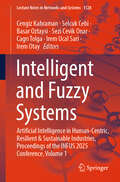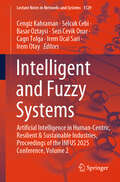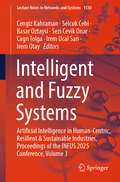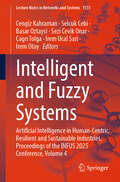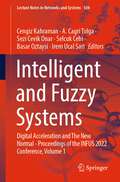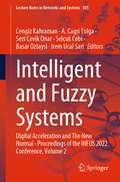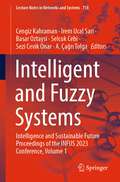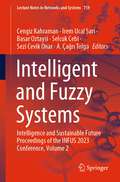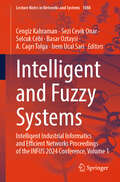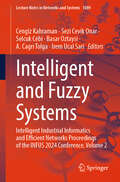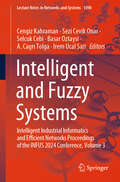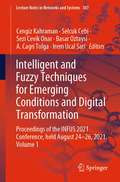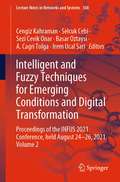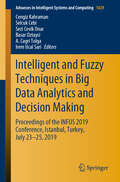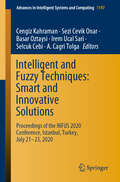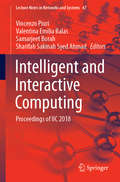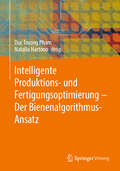- Table View
- List View
Intelligent Wavelet Based Techniques for Advanced Multimedia Applications
by Amit Kumar Singh Mohamed Elhoseny Rajiv Singh Swati NigamThis book contains high-quality research articles and reviews that promote research and reflect the most recent advances in intelligent wavelet based techniques for advanced multimedia applications as well as other emerging areas. In recent time, wavelet transforms have become useful in many signal, image and video processing applications, especially for multimedia security and surveillance. A few applications of wavelets in security and surveillance are watermarking, fusion, steganography, object detection, tracking, motion recognition and intention recognition, etc. Wavelets are well capable of analyzing signal, image and video at different resolution levels, popularly known as multiresolution analysis. The multiresolution analysis is advantageous in multimedia security and surveillance applications. It provides flexibility in selection of different resolution levels that leads to better accuracy. Furthermore, recently sparse representation has become an advancement to analyze wavelet coefficients. It is observed that wavelet transforms possess the invariance property which makes them suitable for many vision applications. This book provides a concise overview of the current state of the art and disseminates some of the novel and exciting ideas and techniques. In addition, it is also helpful for the senior undergraduate and graduate students, researcher, academicians, IT professional and providers, citizens, customers as well as policy makers working in this area as well as other emerging applications demanding state-of-the-art wavelet based multimedia applications.
Intelligent Web Data Management: Software Architectures and Emerging Technologies
by Ajith Abraham Bo Yang Kun Ma Runyuan SunThis bookpresents some of the emerging techniques and technologies used to handle Webdata management. Authors present novel software architectures and emergingtechnologies and then validate using experimental data and real world applications. The contents of this book are focused on four popular thematic categories ofintelligent Web data management: cloud computing, social networking, monitoringand literature management. The Volume will be a valuable reference toresearchers, students and practitioners in the field of Web data management,cloud computing, social networks using advanced intelligence tools.
Intelligent and Cloud Computing: Proceedings of ICICC 2019, Volume 1 (Smart Innovation, Systems and Technologies #194)
by Rajkumar Buyya Srikanta Patnaik Debahuti Mishra Prasant MohapatraThis book features a collection of high-quality research papers presented at the International Conference on Intelligent and Cloud Computing (ICICC 2019), held at Siksha 'O' Anusandhan (Deemed to be University), Bhubaneswar, India, on December 20, 2019. Including contributions on system and network design that can support existing and future applications and services, it covers topics such as cloud computing system and network design, optimization for cloud computing, networking, and applications, green cloud system design, cloud storage design and networking, storage security, cloud system models, big data storage, intra-cloud computing, mobile cloud system design, real-time resource reporting and monitoring for cloud management, machine learning, data mining for cloud computing, data-driven methodology and architecture, and networking for machine learning systems.
Intelligent and Cloud Computing: Proceedings of ICICC 2019, Volume 2 (Smart Innovation, Systems and Technologies #153)
by Rajkumar Buyya Srikanta Patnaik Debahuti Mishra Prasant MohapatraThis book features a collection of high-quality research papers presented at the International Conference on Intelligent and Cloud Computing (ICICC 2019), held at Siksha 'O' Anusandhan (Deemed to be University), Bhubaneswar, India, on December 20, 2019. Including contributions on system and network design that can support existing and future applications and services, it covers topics such as cloud computing system and network design, optimization for cloud computing, networking, and applications, green cloud system design, cloud storage design and networking, storage security, cloud system models, big data storage, intra-cloud computing, mobile cloud system design, real-time resource reporting and monitoring for cloud management, machine learning, data mining for cloud computing, data-driven methodology and architecture, and networking for machine learning systems.
Intelligent and Cloud Computing: Proceedings of ICICC 2021 (Smart Innovation, Systems and Technologies #286)
by Rajkumar Buyya Srikanta Patnaik Debahuti Mishra Prasant MohapatraThis book features a collection of high-quality research papers presented at the International Conference on Intelligent and Cloud Computing (ICICC 2021), held at Siksha 'O' Anusandhan (Deemed to be University), Bhubaneswar, India, during October 22–23, 2021. The book includes contributions on system and network design that can support existing and future applications and services. It covers topics such as cloud computing system and network design, optimization for cloud computing, networking, and applications, green cloud system design, cloud storage design and networking, storage security, cloud system models, big data storage, intra-cloud computing, mobile cloud system design, real-time resource reporting and monitoring for cloud management, machine learning, data mining for cloud computing, data-driven methodology and architecture, and networking for machine learning systems.
Intelligent and Efficient Video Moment Localization
by Liqiang Nie Meng Liu Weili Guan Yupeng HuThis book provides a comprehensive exploration of video moment localization, a rapidly emerging research field focused on enabling precise retrieval of specific moments within untrimmed, unsegmented videos. With the rapid growth of digital content and the rise of video-sharing platforms, users face significant challenges when searching for particular content across vast video archives. This book addresses how video moment localization uses natural language queries to bridge the gap between video content and semantic understanding, offering an intuitive solution for locating specific moments across diverse domains like surveillance, education, and entertainment. This book explores the latest advancements in video moment localization, addressing key issues such as accuracy, efficiency, and scalability. It presents innovative techniques for contextual understanding and cross-modal semantic alignment, including attention mechanisms and dynamic query decomposition. Additionally, the book discusses solutions for enhancing computational efficiency and scalability, such as semantic pruning and efficient hashing, while introducing frameworks for better integration between visual and textual data. It also examines weakly-supervised learning approaches to reduce annotation costs without sacrificing performance. Finally, the book covers real-world applications and offers insights into future research directions.
Intelligent and Evolutionary Systems
by George Leu Hemant Kumar Singh Saber ElsayedOver the last two decades the field of Intelligent Systems delivered to human kind significant achievements, while also facing major transformations. 20 years ago, automation and knowledge-based AI were still the dominant paradigms fueling the efforts of both researchers and practitioners. Later, 10 years ago, statistical machine intelligence was on the rise, heavily supported by the digital computing, and led to the unprecedented advances in and dependence on digital technology. However, the resultant intelligent systems remained designer-based endeavors and thus, were limited in their true learning and development abilities. Today, the challenge is to have in place intelligent systems that can develop themselves on behalf of their creators, and gain abilities with no or limited supervision in the tasks they are meant to perform. Cognitive development systems, and the supporting cognitive computing are on the rise today, promising yet other significant achievements for the future of human kind. This book captures this unprecedented evolution of the field of intelligent systems, presenting a compilation of studies that covers all research directions in the field over the last two decades, offering to the reader a broad view over the field, while providing a solid foundation from which outstanding new ideas may emerge.
Intelligent and Fuzzy Systems: Artificial Intelligence in Human-Centric, Resilient & Sustainable Industries, Proceedings of the INFUS 2025 Conference, Volume 1 (Lecture Notes in Networks and Systems #1528)
by Cengiz Kahraman Selcuk Cebi Sezi Cevik Onar Basar Oztaysi Irem Ucal Sari Cagrı Tolga Irem OtayArtificial Intelligence in Human-Centric, Resilient & Sustainable Industries This book focuses on benefiting artificial intelligent tools in our business and social life under emerging conditions. Human-centric, resilient, and sustainable industries are built on ideals like human-centricity, ecological advantages, or social benefits. The mission of human-centric artificial intelligence is to improve people&’s lives by offering solutions that boost productivity, accessibility to resources, security, well-being, and general quality of life. The latest intelligent methods and techniques on human-centric, resilient, and sustainable industries are introduced by theory and applications. This book covers the chapters of world-wide known experts on machine learning, medical image processing, process intelligence, process mining, and others. The intended readers are intelligent systems researchers, lecturers, M.Sc. and Ph.D. students trying to develop approaches giving human needs, values, and viewpoints top priority through artificial intelligent systems.
Intelligent and Fuzzy Systems: Artificial Intelligence in Human-Centric, Resilient and Sustainable Industries, Proceedings of the INFUS 2025 Conference, Volume 2 (Lecture Notes in Networks and Systems #1529)
by Cengiz Kahraman Selcuk Cebi Sezi Cevik Onar Basar Oztaysi Irem Ucal Sari Cagrı Tolga Irem OtayArtificial Intelligence in Human-Centric, Resilient & Sustainable Industries This book focuses on benefiting artificial intelligent tools in our business and social life under emerging conditions. Human-centric, resilient, and sustainable industries are built on ideals like human-centricity, ecological advantages, or social benefits. The mission of human-centric artificial intelligence is to improve people&’s lives by offering solutions that boost productivity, accessibility to resources, security, well-being, and general quality of life. The latest intelligent methods and techniques on human-centric, resilient, and sustainable industries are introduced by theory and applications. This book covers the chapters of world-wide known experts on machine learning, medical image processing, process intelligence, process mining, and others. The intended readers are intelligent systems researchers, lecturers, M.Sc. and Ph.D. students trying to develop approaches giving human needs, values, and viewpoints top priority through artificial intelligent systems.
Intelligent and Fuzzy Systems: Artificial Intelligence in Human-Centric, Resilient and Sustainable Industries, Proceedings of the INFUS 2025 Conference, Volume 3 (Lecture Notes in Networks and Systems #1530)
by Cengiz Kahraman Selcuk Cebi Sezi Cevik Onar Basar Oztaysi Irem Ucal Sari Cagrı Tolga Irem OtayArtificial Intelligence in Human-Centric, Resilient & Sustainable Industries This book focuses on benefiting artificial intelligent tools in our business and social life under emerging conditions. Human-centric, resilient, and sustainable industries are built on ideals like human-centricity, ecological advantages, or social benefits. The mission of human-centric artificial intelligence is to improve people&’s lives by offering solutions that boost productivity, accessibility to resources, security, well-being, and general quality of life. The latest intelligent methods and techniques on human-centric, resilient, and sustainable industries are introduced by theory and applications. This book covers the chapters of world-wide known experts on machine learning, medical image processing, process intelligence, process mining, and others. The intended readers are intelligent systems researchers, lecturers, M.Sc. and Ph.D. students trying to develop approaches giving human needs, values, and viewpoints top priority through artificial intelligent systems.
Intelligent and Fuzzy Systems: Artificial Intelligence in Human-Centric, Resilient and Sustainable Industries, Proceedings of the INFUS 2025 Conference, Volume 4 (Lecture Notes in Networks and Systems #1531)
by Cengiz Kahraman İrem Otay Selcuk Cebi Sezi Cevik Onar Basar Oztaysi Irem Ucal Sari Cagrı TolgaArtificial Intelligence in Human-Centric, Resilient & Sustainable Industries This book focuses on benefiting artificial intelligent tools in our business and social life under emerging conditions. Human-centric, resilient, and sustainable industries are built on ideals like human-centricity, ecological advantages, or social benefits. The mission of human-centric artificial intelligence is to improve people&’s lives by offering solutions that boost productivity, accessibility to resources, security, well-being, and general quality of life. The latest intelligent methods and techniques on human-centric, resilient, and sustainable industries are introduced by theory and applications. This book covers the chapters of world-wide known experts on machine learning, medical image processing, process intelligence, process mining, and others. The intended readers are intelligent systems researchers, lecturers, M.Sc. and Ph.D. students trying to develop approaches giving human needs, values, and viewpoints top priority through artificial intelligent systems.
Intelligent and Fuzzy Systems: Digital Acceleration and The New Normal - Proceedings of the INFUS 2022 Conference, Volume 1 (Lecture Notes in Networks and Systems #504)
by Cengiz Kahraman Selcuk Cebi Sezi Cevik Onar Basar Oztaysi A. Cagri Tolga Irem Ucal SariThis book presents recent research in intelligent and fuzzy techniques on digital transformation and the new normal, the state to which economies, societies, etc. settle following a crisis bringing us to a new environment. Digital transformation and the new normal-appearing in many areas such as digital economy, digital finance, digital government, digital health, and digital education are the main scope of this book. The readers can benefit from this book for preparing for a digital “new normal” and maintaining a leadership position among competitors in both manufacturing and service companies. Digitizing an industrial company is a challenging process, which involves rethinking established structures, processes, and steering mechanisms presented in this book. The intended readers are intelligent and fuzzy systems researchers, lecturers, M.Sc., and Ph.D. students studying digital transformation and new normal. The book covers fuzzy logic theory and applications, heuristics, and metaheuristics from optimization to machine learning, from quality management to risk management, making the book an excellent source for researchers.
Intelligent and Fuzzy Systems: Digital Acceleration and The New Normal - Proceedings of the INFUS 2022 Conference, Volume 2 (Lecture Notes in Networks and Systems #505)
by Cengiz Kahraman Selcuk Cebi Sezi Cevik Onar Basar Oztaysi A. Cagri Tolga Irem Ucal SariThis book presents recent research in intelligent and fuzzy techniques on digital transformation and the new normal, the state to which economies, societies, etc. settle following a crisis bringing us to a new environment. Digital transformation and the new normal-appearing in many areas such as digital economy, digital finance, digital government, digital health, and digital education are the main scope of this book. The readers can benefit from this book for preparing for a digital “new normal” and maintaining a leadership position among competitors in both manufacturing and service companies. Digitizing an industrial company is a challenging process, which involves rethinking established structures, processes, and steering mechanisms presented in this book. The intended readers are intelligent and fuzzy systems researchers, lecturers, M.Sc., and Ph.D. students studying digital transformation and new normal. The book covers fuzzy logic theory and applications, heuristics, and metaheuristics from optimization to machine learning, from quality management to risk management, making the book an excellent source for researchers.
Intelligent and Fuzzy Systems: Intelligence and Sustainable Future Proceedings of the INFUS 2023 Conference, Volume 1 (Lecture Notes in Networks and Systems #758)
by Cengiz Kahraman Selcuk Cebi Sezi Cevik Onar Basar Oztaysi Irem Ucal Sari A. Çağrı TolgaThis book consists of the papers accepted after a careful review process at an international scientific meeting where the latest developments on intelligent and fuzzy systems are presented and discussed. The latest developments in both the theoretical and practical fields of the new fuzzy set extensions have been prepared by expert researchers. Contributed by participants from more than 40 different countries, this book is also a useful resource in terms of showing the levels that fuzzy and intelligent systems have reached in various countries of the world. The intended readers are intelligent and fuzzy systems researchers, lecturers, M.Sc., and Ph.D. students studying fuzzy sets and artificial intelligence. The book covers fuzzy logic theory and applications, heuristics, and metaheuristics from optimization to machine learning, from quality management to risk management, making the book an excellent source for researchers.
Intelligent and Fuzzy Systems: Intelligence and Sustainable Future Proceedings of the INFUS 2023 Conference, Volume 2 (Lecture Notes in Networks and Systems #759)
by Cengiz Kahraman Selcuk Cebi Sezi Cevik Onar Basar Oztaysi Irem Ucal Sari A. Çağrı TolgaThis book consists of the papers accepted after a careful review process at an international scientific meeting where the latest developments on intelligent and fuzzy systems are presented and discussed. The latest developments in both the theoretical and practical fields of the new fuzzy set extensions have been prepared by expert researchers. Contributed by participants from more than 40 different countries, this book is also a useful resource in terms of showing the levels that fuzzy and intelligent systems have reached in various countries of the world. The intended readers are intelligent and fuzzy systems researchers, lecturers, M.Sc., and Ph.D. students studying fuzzy sets and artificial intelligence. The book covers fuzzy logic theory and applications, heuristics, and metaheuristics from optimization to machine learning, from quality management to risk management, making the book an excellent source for researchers.
Intelligent and Fuzzy Systems: Intelligent Industrial Informatics and Efficient Networks Proceedings of the INFUS 2024 Conference, Volume 1 (Lecture Notes in Networks and Systems #1088)
by Cengiz Kahraman Selcuk Cebi Sezi Cevik Onar Basar Oztaysi Irem Ucal Sari A. Cagrı TolgaThis book presents recent research in intelligent and fuzzy techniques on Intelligent Industrial Informatics and Efficient Networks. This cutting-edge field integrates advanced technologies, such as artificial intelligence, machine learning and data analytics, into industrial processes, revolutionizing the way industries operate. The book presents the examples of the implementation of smart sensors and IoT devices, which facilitate real-time data collection and communication. High-speed, low-latency networks ensure that information flows effortlessly between devices, enabling timely responses and enabling the coordination of complex manufacturing processes. This network architecture supports the integration of edge computing, where data processing occurs closer to the source, reducing latency and enabling faster decision-making. The readers can benefit from this book for maintaining a leadership position among competitors in both manufacturing and service companies. The intended readers are intelligent and fuzzy systems researchers, lecturers, M.Sc. and Ph.D. students studying intelligent and fuzzy techniques. The book covers fuzzy logic theory and applications, heuristics and metaheuristics from optimization to machine learning, from quality management to risk management, making the book an excellent source for researchers.
Intelligent and Fuzzy Systems: Intelligent Industrial Informatics and Efficient Networks Proceedings of the INFUS 2024 Conference, Volume 2 (Lecture Notes in Networks and Systems #1089)
by Cengiz Kahraman Selcuk Cebi Sezi Cevik Onar Basar Oztaysi Irem Ucal Sari A. Cagrı TolgaThis book presents recent research in intelligent and fuzzy techniques on Intelligent Industrial Informatics and Efficient Networks. This cutting-edge field integrates advanced technologies, such as artificial intelligence, machine learning and data analytics, into industrial processes, revolutionizing the way industries operate. The book presents the examples of the implementation of smart sensors and IoT devices, which facilitate real-time data collection and communication. High-speed, low-latency networks ensure that information flows effortlessly between devices, enabling timely responses and enabling the coordination of complex manufacturing processes. This network architecture supports the integration of edge computing, where data processing occurs closer to the source, reducing latency and enabling faster decision-making. The readers can benefit from this book for maintaining a leadership position among competitors in both manufacturing and service companies. The intended readers are intelligent and fuzzy systems researchers, lecturers, M.Sc. and Ph.D. students studying intelligent and fuzzy techniques. The book covers fuzzy logic theory and applications, heuristics and metaheuristics from optimization to machine learning, from quality management to risk management, making the book an excellent source for researchers.
Intelligent and Fuzzy Systems: Intelligent Industrial Informatics and Efficient Networks Proceedings of the INFUS 2024 Conference, Volume 3 (Lecture Notes in Networks and Systems #1090)
by Cengiz Kahraman Selcuk Cebi Sezi Cevik Onar Basar Oztaysi Irem Ucal Sari A. Cagrı TolgaThis book presents recent research in intelligent and fuzzy techniques on Intelligent Industrial Informatics and Efficient Networks. This cutting-edge field integrates advanced technologies, such as artificial intelligence, machine learning and data analytics, into industrial processes, revolutionizing the way industries operate. The book presents the examples of the implementation of smart sensors and IoT devices, which facilitate real-time data collection and communication. High-speed, low-latency networks ensure that information flows effortlessly between devices, enabling timely responses and enabling the coordination of complex manufacturing processes. This network architecture supports the integration of edge computing, where data processing occurs closer to the source, reducing latency and enabling faster decision-making. The readers can benefit from this book for maintaining a leadership position among competitors in both manufacturing and service companies. The intended readers are intelligent and fuzzy systems researchers, lecturers, M.Sc. and Ph.D. students studying intelligent and fuzzy techniques. The book covers fuzzy logic theory and applications, heuristics and metaheuristics from optimization to machine learning, from quality management to risk management, making the book an excellent source for researchers.
Intelligent and Fuzzy Techniques for Emerging Conditions and Digital Transformation: Proceedings of the INFUS 2021 Conference, held August 24-26, 2021. Volume 1 (Lecture Notes in Networks and Systems #307)
by Cengiz Kahraman Selcuk Cebi Sezi Cevik Onar Basar Oztaysi A. Cagri Tolga Irem Ucal SariThis book presents recent research in intelligent and fuzzy techniques. Emerging conditions such as pandemic, wars, natural disasters and various high technologies force people for significant changes in business and social life. The adoption of digital technologies to transform services or businesses, through replacing non-digital or manual processes with digital processes or replacing older digital technology with newer digital technologies through intelligent systems is the main scope of this book. It focuses on revealing the reflection of digital transformation in our business and social life under emerging conditions through intelligent and fuzzy systems. The latest intelligent and fuzzy methods and techniques on digital transformation are introduced by theory and applications. The intended readers are intelligent and fuzzy systems researchers, lecturers, M.Sc. and Ph.D. students studying digital transformation. Usage of ordinary fuzzy sets and their extensions, heuristics and metaheuristics from optimization to machine learning, from quality management to risk management makes the book an excellent source for researchers.
Intelligent and Fuzzy Techniques for Emerging Conditions and Digital Transformation: Proceedings of the INFUS 2021 Conference, held August 24-26, 2021. Volume 2 (Lecture Notes in Networks and Systems #308)
by Cengiz Kahraman Selcuk Cebi Sezi Cevik Onar Basar Oztaysi A. Cagri Tolga Irem Ucal SariThis book presents recent research in intelligent and fuzzy techniques. Emerging conditions such as pandemic, wars, natural disasters and various high technologies force people for significant changes in business and social life. The adoption of digital technologies to transform services or businesses, through replacing non-digital or manual processes with digital processes or replacing older digital technology with newer digital technologies through intelligent systems is the main scope of this book. It focuses on revealing the reflection of digital transformation in our business and social life under emerging conditions through intelligent and fuzzy systems. The latest intelligent and fuzzy methods and techniques on digital transformation are introduced by theory and applications. The intended readers are intelligent and fuzzy systems researchers, lecturers, M.Sc. and Ph.D. students studying digital transformation. Usage of ordinary fuzzy sets and their extensions, heuristics and metaheuristics from optimization to machine learning, from quality management to risk management makes the book an excellent source for researchers.
Intelligent and Fuzzy Techniques in Big Data Analytics and Decision Making: Proceedings of the INFUS 2019 Conference, Istanbul, Turkey, July 23-25, 2019 (Advances in Intelligent Systems and Computing #1029)
by Cengiz Kahraman Selcuk Cebi Sezi Cevik Onar Basar Oztaysi A. Cagri Tolga Irem Ucal SariThis book includes the proceedings of the Intelligent and Fuzzy Techniques INFUS 2019 Conference, held in Istanbul, Turkey, on July 23–25, 2019. Big data analytics refers to the strategy of analyzing large volumes of data, or big data, gathered from a wide variety of sources, including social networks, videos, digital images, sensors, and sales transaction records. Big data analytics allows data scientists and various other users to evaluate large volumes of transaction data and other data sources that traditional business systems would be unable to tackle. Data-driven and knowledge-driven approaches and techniques have been widely used in intelligent decision-making, and they are increasingly attracting attention due to their importance and effectiveness in addressing uncertainty and incompleteness. INFUS 2019 focused on intelligent and fuzzy systems with applications in big data analytics and decision-making, providing an international forum that brought together those actively involved in areas of interest to data science and knowledge engineering. These proceeding feature about 150 peer-reviewed papers from countries such as China, Iran, Turkey, Malaysia, India, USA, Spain, France, Poland, Mexico, Bulgaria, Algeria, Pakistan, Australia, Lebanon, and Czech Republic.
Intelligent and Fuzzy Techniques: Proceedings of the INFUS 2020 Conference, Istanbul, Turkey, July 21-23, 2020 (Advances in Intelligent Systems and Computing #1197)
by Cengiz Kahraman Selcuk Cebi Sezi Cevik Onar Basar Oztaysi A. Cagri Tolga Irem Ucal SariThis book gathers the most recent developments in fuzzy & intelligence systems and real complex systems presented at INFUS 2020, held in Istanbul on July 21–23, 2020. The INFUS conferences are a well-established international research forum to advance the foundations and applications of intelligent and fuzzy systems, computational intelligence, and soft computing, highlighting studies on fuzzy & intelligence systems and real complex systems at universities and international research institutions. Covering a range of topics, including the theory and applications of fuzzy set extensions such as intuitionistic fuzzy sets, hesitant fuzzy sets, spherical fuzzy sets, and fuzzy decision-making; machine learning; risk assessment; heuristics; and clustering, the book is a valuable resource for academics, M.Sc. and Ph.D. students, as well as managers and engineers in industry and the service sectors.
Intelligent and Interactive Computing: Proceedings of IIC 2018 (Lecture Notes in Networks and Systems #67)
by Vincenzo Piuri Valentina Emilia Balas Samarjeet Borah Sharifah Sakinah Syed AhmadThis book presents the latest research on computational approaches to learning. It includes high-quality peer-reviewed papers from the “Intelligent and Interactive Computing Conference (IIC 2018)” organized by the Universiti Teknikal Malaysia, Melaka. It uses empirical studies, theoretical analysis, and comparisons with psychological phenomena to show how learning methods can be employed to solve important application problems. The book also describes ongoing research in various research labs, universities and institutions, which may lead to the development of marketable products.
Intelligent, Secure, and Dependable Systems in Distributed and Cloud Environments: Second International Conference, ISDDC 2018, Vancouver, BC, Canada, November 28–30, 2018, Proceedings (Lecture Notes in Computer Science #11317)
by Isaac Woungang Issa Traore Sherif Saad Ahmed Yasir MalikThis book constitutes the refereed proceedings of the Second International Conference on Intelligent, Secure, and Dependable Systems in Distributed and Cloud Environments, ISDDC 2018, held in Vancouver, BC, Canada, in November 2018. The 10 full papers were carefully reviewed and selected from 28 submissions. This book also contains the abstracts of two keynote talks and one tutorial. The contributions included in this proceedings cover many aspects of theory and application of effective and efficient paradigms, approaches, and tools for building, maintaining, and managing secure and dependable systems and infrastructures, such as botnet detection, secure cloud computing and cryptosystems, IoT security, sensor and social network security, behavioral systems and data science, and mobile computing.
Intelligente Produktions- und Fertigungsoptimierung - Der Bienenalgorithmus-Ansatz
by Duc Truong Pham Natalia HartonoDieses Buch ist das erste Werk, das sich mit dem Bienenalgorithmus beschäftigt. Nach einer sanften Einführung in die wichtigsten Ideen, die dem Algorithmus zugrunde liegen, stellt das Buch aktuelle Ergebnisse und Entwicklungen im Zusammenhang mit dem Algorithmus und seiner Anwendung auf Optimierungsprobleme in Produktion und Fertigung vor.Mit dem Beginn der vierten industriellen Revolution sind Produktions- und Fertigungsprozesse und -systeme immer komplexer geworden. Um die beste Leistung aus ihnen herauszuholen, sind effiziente und effektive Optimierungstechniken erforderlich, die nicht von der Verfügbarkeit von Prozess- oder Systemmodellen abhängen. Solche Modelle sind in der Regel entweder nicht verfügbar oder aufgrund des hohen Grades an Nichtlinearität und Unsicherheiten in den darzustellenden Prozessen und Systemen mathematisch schwer zu lösen. Der Bienenalgorithmus ist eine leistungsstarke, schwarmbasierte, intelligente Optimierungs-Metaheuristik, die vom Suchverhalten der Honigbienen inspiriert ist. Der Algorithmus ist konzeptionell elegant und extrem einfach anzuwenden. Alles, was er zur Lösung eines Optimierungsproblems benötigt, ist ein Mittel zur Bewertung der Qualität potenzieller Lösungen. Dieses Buch zeigt die Einfachheit, Effektivität und Vielseitigkeit des Algorithmus und ermutigt Ingenieure und Forscher auf der ganzen Welt, ihn weiter einzusetzen, um eine intelligente und nachhaltige Fertigung und Produktion im Zeitalter von Industrie 4.0 und darüber hinaus zu realisieren.
